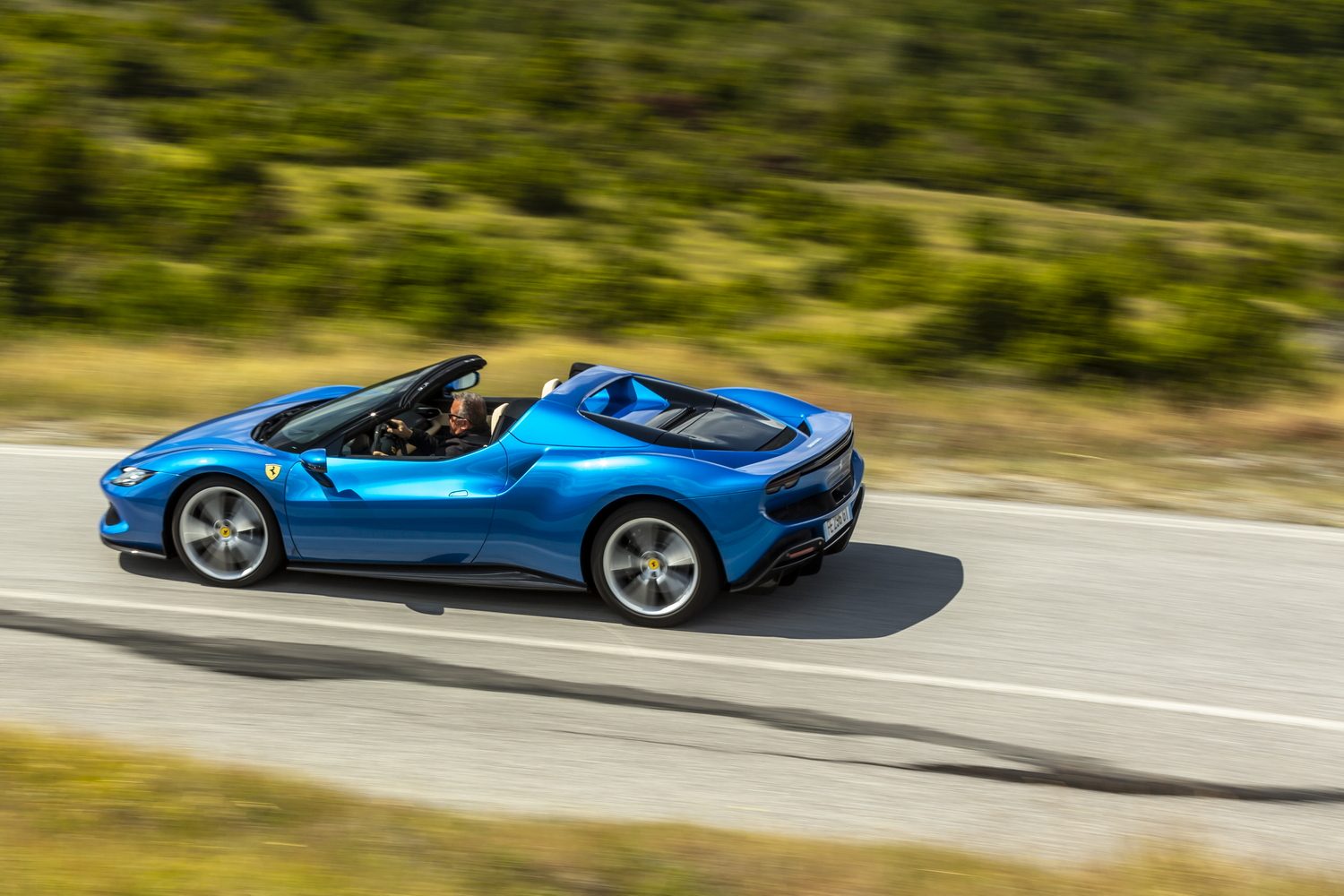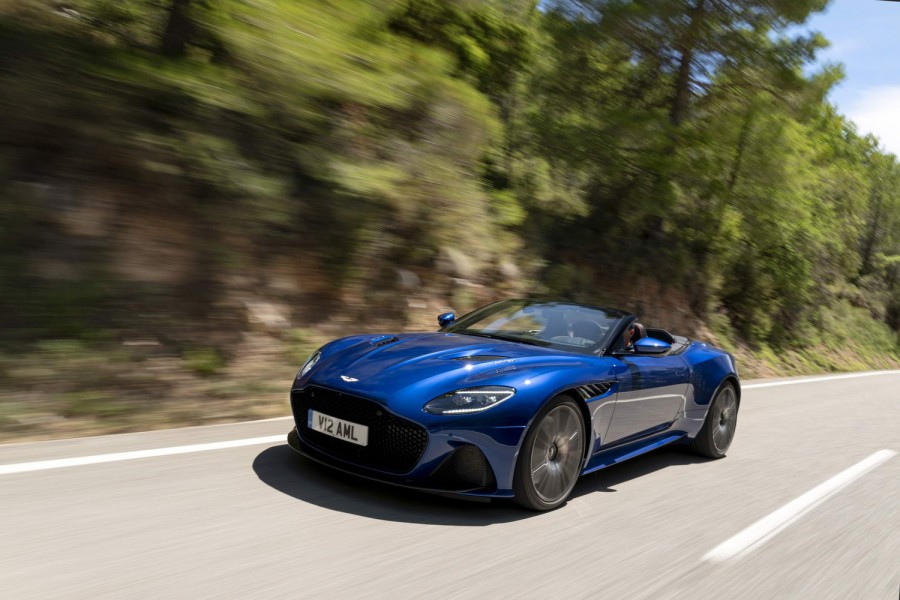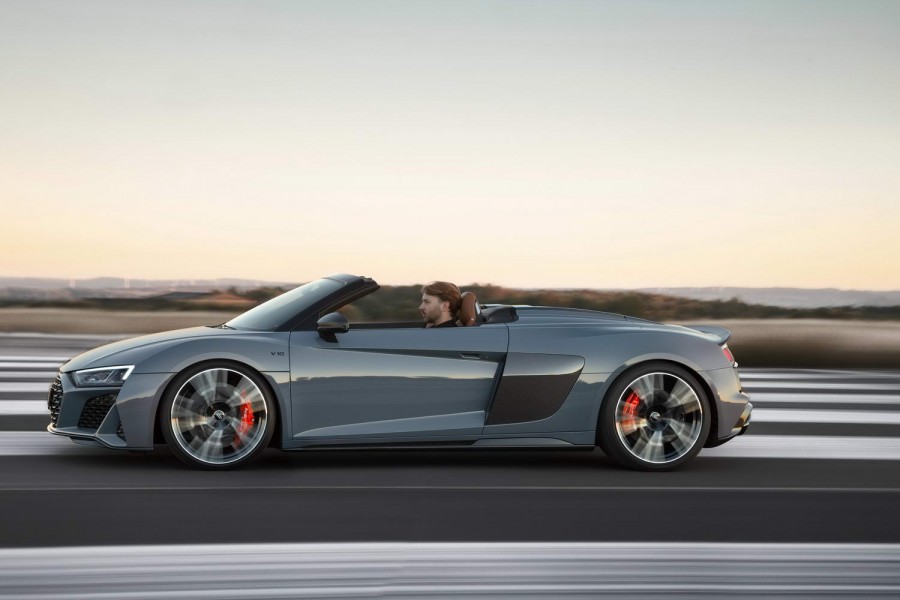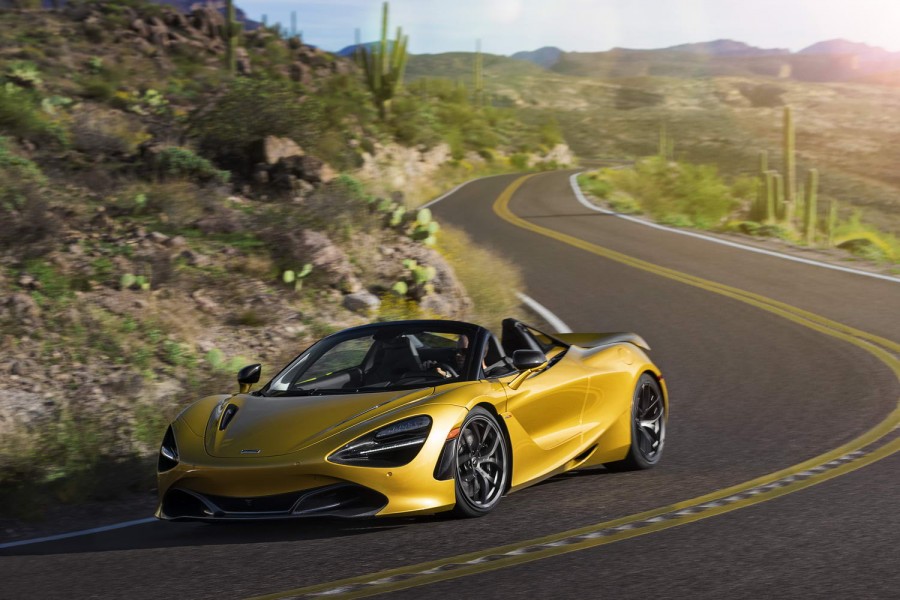Ferrari is no stranger to open-topped cars. Its very first road car had no roof and there have been open versions of a large proportion of its vehicles. It was no surprise then when Ferrari announced the arrival of its latest, the 296 GTS. Indeed, it was conceived, designed and developed at the same time as the 296 GTB coupe. As we're already established, that's a plug-in hybrid supercar to be reckoned with. Can the same formula be translated to the roofless GTS?
In the metal
The Ferrari 296 GTS was designed at the same time as the GTB coupe, so it shouldn't be surprising that the rear of the open version appears so similar. It even keeps the glass cover so you can see the V6 engine underneath. Ferrari also claims that the GTS and GTB produce the same amount of downforce and drag.
That fact perhaps understates how much work was required on the GTS, as aft of the doors, the bodywork is actually quite different in its detail. It retains the GTB's characteristic rear haunches though, unashamedly harking back to the 1964 Ferrari 250 LM. They, and the massive air intakes at their leading edges, loom large in the door mirrors when you take a glance rearwards from the driver's seat, helping make you feel ensconced in the car, despite the minimal front end and distinctly cab-forward layout.
The roof itself is an aluminium panel and it fits snugly in place to give the GTS more or less the same ambience as its coupe sibling. It takes 14 seconds to open or close the roof, and that can be done at up to 45km/h. There's a vertical glass panel behind the seats that can additionally be raised or lowered electrically (whether the roof is up or down), to allow your ears better access to the engine and exhaust note behind.
Pictures don't seem to capture the stance of the 296, as it appears much tauter and wider in person, especially when viewed from the back. There, the large central exhaust outlet mirrors the size and shape of the stylish rear lights, while the buttressing is joined by an 'aero bridge' that almost disguises the open nature of the car.
Push one of the dinky flush-fitting buttons to open the door and you lower yourself into a firm sports seat. The leather is of high quality, but there's not much padding. Thankfully, there's lots of adjustment in the seat and the steering wheel, and a day at the wheel didn't raise any concerns over the comfort. It's possible to option a neck-warming system built into the seats, too.
Though the GTS's steering wheel is no different to that of the GTB, it bears repeating how it, at first, seems an ergonomic mess. The indicator buttons work well enough once you're used to them, though they're tricky to use if the wheel is turned upside down. The rack is direct, so that doesn't happen very often, I'll concede. The wheel also houses a tiny touch-pad to operate the digital screen in front of the driver. It's not the most efficient way to do such things, and there are tiny hidden switches behind the wheel, including a too-light roller for volume. It's a little bewildering at first, in truth, especially if you're trying to focus on driving the thing. However, all this criticism dissipates when you realise that an owner of the car will take time to get used to it, and there will be a perverse pleasure in knowing that not just anyone can get into your car and know how to use it properly.
As the battery pack sits low down across the width of the car, behind the seats, there's only room there for a small ledge for a quoted 49 litres of luggage. Otherwise, the space under the bonnet holds the same 201 litres as the GTB.
Driving it
Officially, the 296 GTS can travel up to 25 kilometres on electric power. It has a 7.45kWh battery pack to enable that, which can be charged up from an external source. It feeds a 122kW electric motor that sits between the engine and the eight-speed dual-clutch gearbox. The car is eerily quiet when driven in its eDrive setting, allowing stealthy departures in the early hours of the morning or relaxing pootling around town.
On the left side of the steering wheel is a touch-sensitive area to choose the hybrid driving mode. Along with purely electric driving there's the Hybrid mode for everyday driving, Performance mode for 'spirited', persistent use of the engine (though keeping the battery topped up) and finally 'Qualify' for absolute maximum performance using the engine and motor, with no regard for keeping the battery charged. Interestingly, while we suspect that few 296 owners will ever plug the car in to charge it up, the battery pack is quickly charged by the car when it's in the Performance mode.
The electric motor adds to the engine's output to send up to 830hp and 740Nm of torque to the rear wheels. The engine is a twin-turbocharged 2.9-litre V6 that Ferrari likes to refer to as its "Little V12".
That's because it put so much effort into making it sound like one, perhaps in a bid to stave off questions about the appropriateness of having a V6 engine in a Ferrari supercar. There are no synthesised sounds or use of the stereo speakers at work, though. Instead, Ferrari came up with a series of ducts and what it calls the "Hot Tube" to channel aspects of the engine's sounds to the cabin. At low revs it sounds more like a V6, but when you get a chance to extend it towards its 8,500rpm redline, it wails and shrieks in a manner that makes you soon forget how many cylinders are hammering up and down.
And if the rousing noise isn't enough to hold your attention, the ferocious performance certainly will. The 0-100km/h time doesn't convey just how savagely this car can accelerate when you push the throttle pedal all the way down, in seemingly any gear. Naturally, you can only use a fraction of its speed on the public road, but it's exciting stuff even within speed limits.
Somehow, the chassis isn't outshone by the powertrain. What's more, though the 296 GTS gets supercar performance, it's entirely usable. Ferrari has managed to make it relatively easy to drive quickly, and certainly not intimidating in most of its settings. The steering is brimming with feedback, and though it's never nervous feeling, it also manages to be deliciously direct, making tight and twisty roads something to relish and seek out.
Do that and you're unlikely to make the brakes sweat. Stopping power is immense, and there's something geekily satisfying to know that there are holes in the headlights that channel cooling air to the special 'Aero' brake callipers. Perhaps more impressive is the brake pedal feel and modulation. Remember, this car has to balance brake energy regeneration, too. It does it all exceedingly well, offering the driver a solid, reassuring brake pedal at all times. You'd never guess it's a 'brake-by-wire' setup.
When the road turns interesting, you'll also want to take control of the gear-changing for yourself, if nothing else to summon up unnecessarily gratuitous early down-changes so you can hear the V6 rapidly blip its throttle. You can toggle between automatic and fully-manual modes using the stylised set of switches on the centre console that harks back, in design terms, to the metal open gates of Ferrari's yesteryear. Instant response to the large, tactile gearchange paddles is very much a modern-day phenomenon, however, and it's a joy to go up and down the gearbox for nothing more than pleasure.
The fun doesn't end there. All the sub-systems are adjusted depending on the setting of the main 'Manettino' switch on the right side of the steering wheel. This is still a wonderfully tactile anodised aluminium switch, though it has been modernised with digital graphics. There is a Wet setting for when the weather isn't great, designed for safety really.
The Sport mode is ideal for dry roads, while the Race setting notches everything up noticeably for a more intense experience. You'll want a smooth road or race circuit for that, though, as the suspension is incredibly firm in this mode. You can press the switch to activate the 'bumpy road' setting, admittedly. Whichever, the car is breath-takingly fast and capable, however, allowing the experienced driver to really flirt with the limits of adhesion. On track, it must allow for devastatingly quick lap times. For those that still think that's too restrictive, there's a CT OFF mode.
Luckily, mere mortals will still love how the 296 drives at regular road speeds. You can really lean on its tyres and feel the electronically controlled rear differential at work as you power out of corners. Although it all feels organic and natural, there's a veritable army of sensors and electronic sub-systems at work. At the centre of it all is the 6-way Chassis Dynamic Sensor (6w-CDS), measuring both the acceleration and the speed of rotation on three axes, information that is then fed back into all the other control systems, such as the special anti-lock brakes. And then there's the electronic Side Slip Control (eSSC) that monitors the steering angle along with a myriad other data points, all in a bid to allow you push the rear tyres to their limits in any given situation.
Its performance is otherworldly, and yet all this technical wizardy makes it accessible. That's a great party trick.
Finally, despite all this, the 296 can manage long motorway journeys and even poor road surfaces (so long as you're not in the Race mode), making it a laughably usable supercar.
What you get for your money
It's likely that some of the features mentioned above are not standard-fit, as Ferrari owners are used to paying considerably more than the list price to personalise their cars. Apple CarPlay is extra, for example, as is a wireless car charger. Away from the mundane, about a third of 296 GTS buyers are expected to upgrade to the Assetto Fiorano package, adding adjustable Multimatic dampers, more carbon fibre components to reduce weight and extra aerodynamic measures. Most examples shown with that package feature extra striping and stunning carbon fibre wheels, too, though they're not included in the price...
An Irish buyer that wants a 296 GTS needs to get in touch with Charles Hurst Ferrari in Belfast. Based on the expected UK starting price of about £280,000, we'd estimate that it'd cost at least €450,000 to import south of the border.
Summary
As no normal driver will ever notice the difference between how the 296 GTB and GTS drives, the choice comes down to personal preference. What's more, the GTS effectively feels like a coupe when its roof is up, so arguably the coupe is superfluous in the line-up. Whichever you're looking at, don't for a second think that the plug-in hybrid powertrain takes from the recipe, as because of it, not despite it, the 296 is a beguiling Ferrari supercar. It just happens to be one with a wider breadth of capability than before. And that's furthered in the GTS.




















































